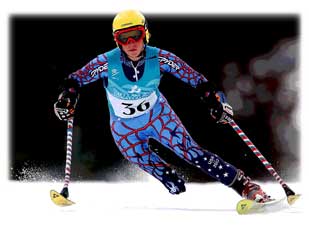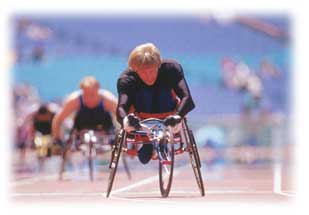VICTORIES BY AND FOR THE DISABLED
By Susan Greenwald

New laws and changing public attitudes have created opportunities previously unavailable for persons with disabilities to participate in recreational and competitive sports. Some disabled athletes even compete among the able-bodied at the interscholastic, international, and professional levels.
Each winter, in the snow-packed mountains around Northern California's Lake Tahoe, skiers and chair lifts whiz by a small wood-covered building at the base of one of the mountains. Skis are propped up against the building's exterior walls, next to empty wheelchairs that seem to be out of place until one realizes that this building houses the first ski school fully accessible to persons with mental and physical disabilities. The Tahoe Adaptive Ski School, designed and constructed by Disabled Sports USA, Far West chapter (http://www.dsusafw.org), is a model for the opportunities it allows disabled skiers of all ages and abilities.
 |
Disabled Americans, like Winter Paralympics athlete Allison Jones above, compete in numerous sports. |
According to the 2000 U.S. Census, there are 49.7 million Americans over the age of four with a disability. That represents 19 percent of the population, or one in five citizens. Among that 19 percent, 14.3 million Americans have a mental disability and 2.2 million say they use a wheelchair. For those wheelchair users and others with physical and mental disabilities, the Tahoe Adaptive Ski School offers a downhill or cross-country ski experience.
But sports opportunities for the disabled extend far beyond skiing. Depending on community offerings and the ability of each athlete, sports as diverse as hockey, horseback riding, rock climbing, scuba diving, cycling, water skiing, rugby, soccer, basketball, and many, many other sports are available to disabled athletes.
Overcoming Discrimination
Three pieces of federal legislation have opened doors in all aspects of life for people with disabilities in the United States. The Rehabilitation Act, adopted in 1973, was the first major initiative in this regard. The main purpose of the Act was to prevent discrimination in employment, transportation, and education programs that received federal funding. Sports programs were not the focus of the Act, but the law says that colleges and universities that receive federal funding for their physical education programs, including intramural and interscholastic sports, must make them accessible to disabled persons.
Pitcher Jim Abbott, who played baseball at the University of Michigan and moved on to the professional major leagues for 10 years, is just one example of someone who may have benefited from the Rehabilitation Act. Born without a right hand, Jim pitched with his left hand and wore a glove over the small stump where his right hand should have been. For several years, until his retirement in 1999, Abbott made more than $2 million a year. It is quite an accomplishment for a baseball player to go directly from college baseball to the major leagues, but Jim made the transition look easy – just as he made the quick switch of his glove from right-hand stump to left hand immediately after throwing a pitch look easy. This he did to be ready to catch a ball.
The most recent pieces of federal legislation aimed at ending discrimination against persons with disabilities were enacted in 1990. The Individuals with Disabilities Education Act (IDEA) governs the education of students with disabilities in the public schools. IDEA states that physical education is a required educational service; thus the law facilitates participation of students with disabilities in public school and interscholastic sports programs. The Americans with Disabilities Act (ADA) is a comprehensive law that bans discrimination against persons with disabilities, specifically in "places of exercise." The ADA goes further than the previous laws and says that school, university, and community sports programs all must comply with ADA provisions.
In a landmark 2001 case, professional disabled golfer Casey Martin took his case against the PGA Tour all the way to the United States Supreme Court. The Court ruled that under provisions of the ADA, PGA Tour, Inc., must permit Martin use of a golf cart during tournaments. Martin went on to win a professional golf event in spite of a congenitally deformed and atrophied leg, the result of a degenerative circulatory disorder.
Disability-rights advocates say the ADA requires reasonable access to sporting facilities and events for the disabled. "People with disabilities demand choices in their lives based on the ADA and the heightening of social acceptance," said John Kemp, an attorney and disabilities advocate who was born with no arms and no legs. "Sports is a valued choice and disabled athletes expect to be included as much as possible."
 |
Wheelchair events and the Paralympics are a staple of the American sports scene these days. |
Changing Perceptions
Seeing disabled athletes competing alongside able-bodied athletes in the same events changes the public's perception of persons with disabilities. However, despite better awareness of disabilities and the three federal laws enacted to end discrimination, not all event sponsors welcome disabled athletes with open arms. According to news accounts, the New York City Road Runners Club, hosts of the New York City Marathon (NYCM), have never made it easy for people with disabilities to participate in the race. Advocates for the disabled say the welcome mat seems to get smaller each year. After years of controversy and struggles, wheelchair racers won a court decision against NYCM that required organizers to provide an early start for wheelchair racers.
While the Rehabilitation Act, IDEA, and ADA have made sports more accessible to disabled athletes, the International Paralympic Games ( http://www.paralympic.org) offer a venue in which to showcase the talents and abilities of the world's most elite athletes with physical disabilities. The multi-sport Paralympic Games are the second largest sporting event in the world, second only to the Olympics. .
|
The first Paralympics were held in 1960 in Rome, Italy. In 1988, Seoul, South Korea, began the modern-day practice of the Olympic Games-host nation also hosting the Paralympic Games. Today more than 4,000 athletes from 120 countries participate in the Summer Paralympics, while more than 1,100 athletes from 36 countries compete in the Winter Paralympic Games. Disability groups represented include amputees; blind or visually impaired athletes; athletes with cerebral palsy, spinal cord injuries, or other conditions that confine them to wheelchairs; and athletes who are affected by a range of other disabilities that do not fall into a specific category, such as multiple sclerosis or dwarfism.
The Paralympics receive much more television and general press coverage throughout Europe than they do in the United States. Paralympic athletes generally are well known in Europe. "Many people with disabilities in the U.S. do not enjoy the level of acceptance that disabled athletes in Europe do," said John Kemp, president and CEO of HalfthePlanet Foundation (http://www.halftheplanet.org). But the U.S. Paralympic Committee (http://www.usparalympics.org) aims to change that. U.S. Paralympics is a division of the U.S. Olympic Committee and was created in May 2001 to focus efforts on enhancing opportunities for persons with physical disabilities to participate in Paralympic sports. The United States hosted the most recent Winter Paralympics in Salt Lake City, Utah, in 2002.
Marla Runyon, a five-time Paralympic gold medallist, became the first legally blind runner to qualify for the U.S. Olympic team. Diagnosed with Stargardt's Disease as a child, Marla has been legally blind for more than 20 years. Marla ran the 1500-meter race at the Sydney Summer Olympics in 2000 to finish eighth, while becoming the first Paralympian to compete in the Olympics. She now has long distance aspirations. In the 2002 New York City Marathon, Marla finished fifth among the fastest runners in the world with a time of 2:27:10. In 2003, she finished a personally disappointing 20th.
Doing What It Takes
Also finishing the 2003 NYC marathon, just a day later than the other competitors, was 55-year-old Zoe Koplowitz, with a time of 29 hours and 45 minutes. Time is not an issue for Koplowitz, who was diagnosed with diabetes and multiple sclerosis 30 years ago. She uses two purple crutches to get through the course and stops often to rest and check her blood levels. "I think that's really the ultimate lesson, you just keep going until you get it done," she told reporters at the finish line after completing her 16th appearance in this event. "You do what it takes."
There are many stories of courageous, determined, disabled athletes who won't let anything get in the way of their athletic pursuits. Mark Wellman, who was paralyzed in a rock climbing accident, developed a pulley rope system to enable him to climb as a paraplegic. This amazing rock climber (http://www.nolimitstahoe.com) ascended a 120-foot rope with the Paralympic torch, to light the Cauldron at the 1996 Paralympic Games in Atlanta, Georgia.
Creative adaptation is not just for paralyzed athletes. A device that emits guiding lights and tones enables the blind and visually impaired to compete in bowling. Constructed as a senior design project during the 2002-2003 school year for physical education classes at the Indiana School for the Blind, the device is positioned above the bowling lane and features a set of nine white lights and sound sensors that serve as targets.
Special Olympics (http://www.specialolympics.org) is perhaps the best-known organization for athletes with developmental disabilities. Special Olympics offers children and adults with mental retardation the opportunity to train and compete in 26 Olympic-type summer and winter sports. In Somers, New York, E.J. Greczylo, a 15-year-old eighth grader with Down's syndrome, played in his first high school football game this past October. E.J.'s parents credit Special Olympics with giving him the confidence to play and compete in many sports.
This past fall produced some wonderful football moments. In September, Neil Parry, a football player for San Jose State University, was playing with his team for the first time in two seasons. Neil suffered a compound fracture on October 14, 2000, in a game against the University of Texas-El Paso that resulted in his right leg being amputated 18 inches below the knee. Eighteen months and 20 surgeries later, Neil returned to the field with the aide of a prosthetic device, inspiring all who know him with his determination. "If you can't be motivated [by Neil], you can't be motivated," head coach Fitz Hill said. "You don't have a pulse."
Not all athletes strive to compete at the intercollegiate level like Neil Parry or for Olympic greatness like Marla Runyon. The majority compete for exercise, for enjoyment, or to achieve personal goals. But an extra measure of creativity and innovation is usually required to enable disabled athletes to play and compete. Happily, today we have hundreds, maybe thousands, of examples of individuals who, in one way or another, have contributed to making participation in sports possible for persons with disabilities.
Freelance writer Susan Greenwald, who uses a wheelchair, began writing about disabled athletes after working at the 1996 Paralympics in Atlanta, Georgia.
